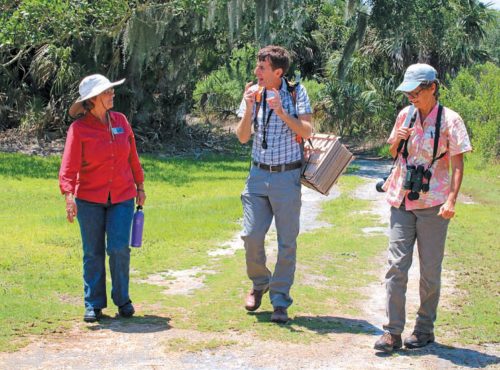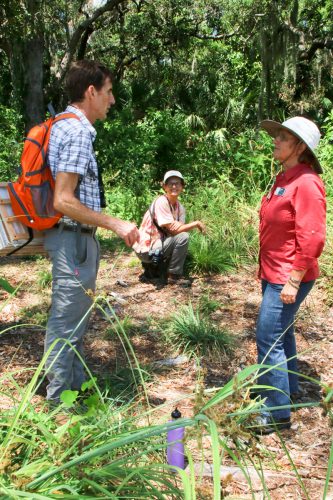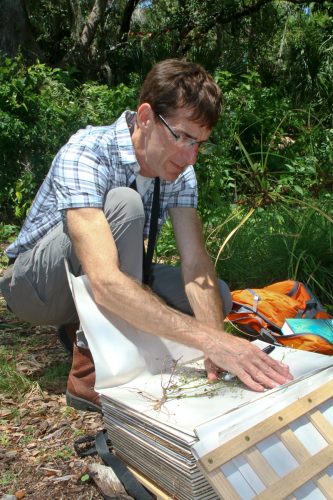Visitors to the Calusa Heritage Trail come for a variety of reasons—some to learn about the archaeology, some for the fresh air, some to see some of the 100+ kinds of birds that come through the site.

And, almost everybody notices the diverse array of interesting plants, some familiar, some not so familiar. We’ve written in our newsletter about the astounding variety of native plants that sprang up in the new section of the Trail after the invasive vegetation was removed.
So, we were particularly excited when we scheduled Marc Frank, Extension Botanist and Associate Collection Manager, Florida Museum, to provide a talk in our One World Lecture Series and he offered to also take us botanizing on the grounds. His talk “Understanding Plant Toxicity” on April 20 was attended by plant enthusiasts from Lee, Collier, and Charlotte counties.

One outcome of botanizing is often the addition of plants to a herbarium, another is greater understanding of biodiversity on a landscape which can then guide restoration work. A herbarium is similar to a library. It holds a collection of dried, labeled, stored, and organized plant samples that can be referred to for study and education. Established in 1891 and housed in the Florida Museum of Natural History, the UF Herbarium contains about 273,000 vascular plants (including both pressed/mounted specimens and a seed collection), 160,000 bryophytes and lichens, 56,500 fungi, and 15,300 wood samples. It includes specimens from every continent except Antarctica, with an emphasis on Florida. It also contains a library of more than 5,000 books, 500 maps, and 1,000 botanical illustrations.
Most herbarium samples begin as pressed plants which are then flattened, dried, and mounted on archival paper. Some herbaria also include mosses, algae, fungi, or lichens in archival paper packets, seeds, wood sections, pollen, microscope slides, DNA extractions, and jars of plant parts.
DID YOU KNOW? About 10% of non-Florida-native plants tend to be invasive.
Because there are very fine levels of similarities or differences that require very close-up and careful study, we quickly found ourselves eye level with plants as Marc made careful positive identifications. If the identification was questionable, Marc referred to detailed taxonomic “keys” – written instructions that tell the observer how to be sure of a plant identification.

Laura Coglan, Head Grounds Volunteer, joined Marc and Cindy Bear, RRC Co-Director, for the afternoon. Laura has a strong botany background and found it enriching to learn even more about how to “key out” plants: “What I learned from Marc is how wonderfully fascinating plant ID [identification] is, and how essential it is to use a botanical key in finding precise ID’s. Marc showed me it can be fun and easy if you know your terminology, have a copy of the Guide to Vascular Plants, and a good magnifying glass!”
Marc validated for us the presence on our grounds of a single plant of Solanum diphyllum, a non-native species of Night shade that is listed as a Category II exotic invasive species by the Florida Exotic Pest Plant Council. We carefully hand pulled this invader and will be watching for its presence other places on the grounds. He also gathered samples of several plant species for the herbarium including the challenging-to-identify newcomer on our site, Jack in the Bush (Chromolaena odorata).
Marc’s visit will result eventually in an up-to-date list of plants identified on our grounds – whether common, rare, or endangered, native or not, invasive or not. This will in turn help our staff and volunteers manage the property’s plant life for maximum sustainability and allow us to pass on the information to all interested visitors.